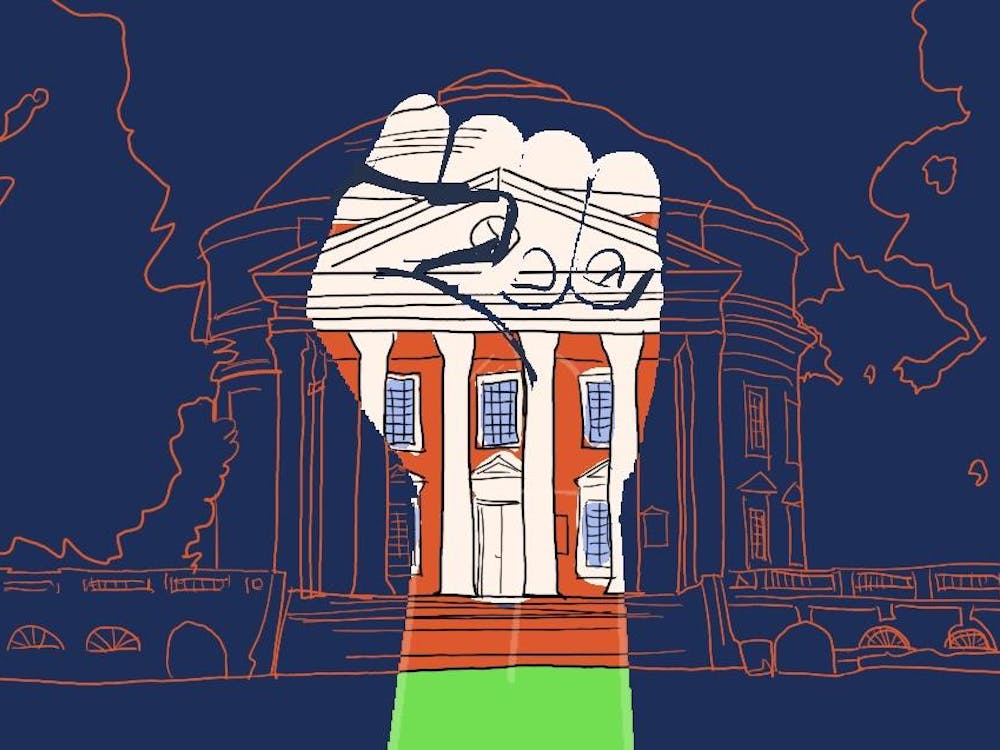"WHO SAYS the University isn't diverse?" smirked a student in front of me as he recited the bold print on The Cavalier Daily: "U.Va. ranks first for black enrollment."
In case you haven't heard the administration's loud trumpeting, two weeks ago the reputable Journal of Blacks in Higher Education ranked the University first out of 30 other top-notch institutions in black enrollment.
The University rejoiced, and rightly so. Who can blame the administration for cherishing a rare triumph before the usual barrage of 'white' and 'elitist' accusations resurfaced? And so, Bill Harvey, chief officer for diversity and equity at the University, gave the usual diplomatic statement about the "more welcoming environment" the University had ushered via its high black graduation rate and academic reputation.
But then, Harvey took his euphoria one step too far. "The University is anxious to celebrate its diversity," he said. A combination of laughter and alarm caused me to choke on my Newcomb processed scrambled eggs. The University's poor record on diversity played back in the attic of my memory, from the Curriculum Globalization initiative to its virtual negligence of the Asian American community.
Harvey's comment did not just disrupt my meal -- it upset my stomach. It epitomized a familiar pattern we see at the University, where the administration inflates small achievements to fool an already apathetic, apolitical student body and then not only lives to tell the tale, but soars through the sky in conceit. In reality, the University's record on black enrollment and related 'diversity issues' is more mixed and sober than the administration makes it out to be.
Torture numbers enough and they will confess to almost anything. Or, you could err on the side of human rights and play the game of statistical deception: Simply pick your favorite number and leave out the rest that don't fit.
But two can play that game. My research using statistics from the University's own enrollment report released July 2007 tells the more complete story about black enrollment at the University. In the section labeled "undergrad fall headcount enrollment by ethnicity and race," undergraduate black enrollment at the University falls steadily from 1996 to 2006. In 1996, 1,334 black students were enrolled, which was 10.2 percent of all undergraduates. This declined in 2001 with 1,230 blacks (8.9%), and then to 1,187 blacks (8.1%) in 2006.
For most of recent history, the University's record on black enrollment has been a source of shame, not glory. If students would care to read the fine print in the Journal's full article available online, it says that the University "backpedaled somewhat in its commitment to increasing the racial diversity of its student body" beginning from 1996. It was only this year that the University is beginning to show signs of reversing that trend.
I say beginning because the advances thus far have been nothing more than baby steps. In a February 2006 diversity report, then Dean of African American Affairs M. Rick Turner suggested that the numbers of blacks entering the University was "much too low." He said the 2005 figures of 1,188 enrolled black undergraduates was only a small improvement over the dismal average total black enrollment of the last five years. Taking two steps back and one step forward should not be equated with progress.
I suspect that if we take Dean Turner's skeptical approach, we might find that the University's record is much more dim than meets the eye. As I pointed out earlier, the number of total black undergraduates actually decreased from 2005 to 2006, which questions the administration's suggestion that 2005 was the beginning of a turnaround in diversity efforts. During the 2007-08 year, only 9% of students - 1,227 people - are black.We would also do well to remember that diversity does not refer to just 'blacks.' By far the most ironic thing to me is that the University seems to measure diversity solely with regard to African American issues, which misrepresents the very meaning of the term. In actuality, diversity refers to a vast array of groups including blacks, Asians, Hispanics and even low-income students.
If we measure the University's record on this broader conception of diversity, there aren't many reasons to celebrate. Readers who venture beyond the headlines will note, for instance, that the Journal released another report chastising universities for the poor enrollment of low-income students. The University ranked third from the bottom of the 30 universities surveyed. I reckon Harvey, who was not in town to respond to phone calls, would be less anxious to celebrate this kind of diversity. The University has taken some steps to improve black enrollment through its various peer advisor and mentoring programs. But every celebration must be tempered by a dose of reality, lest glory give way to conceit. And that would be the last thing an apolitical student body and change-averse administration need
Prashanth Parameswaran's column appears Wednesdays in The Cavalier Daily. He can be reached at pparameswaran@cavalierdaily.com.






